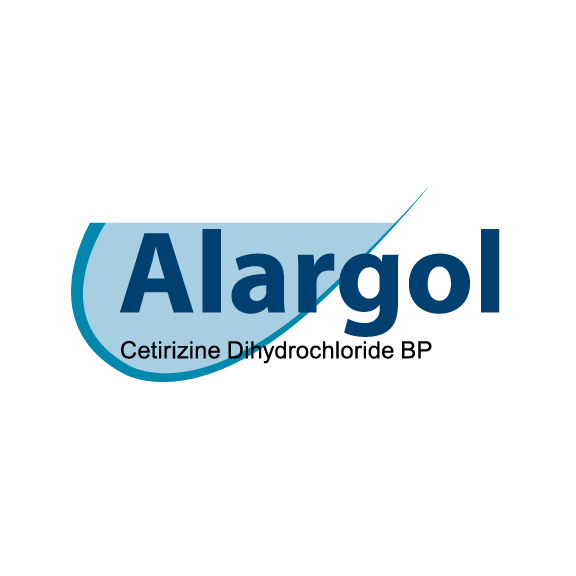ALARGOL® – Cetirizine Hydrochloride bp
COMPOSITION
Available in 2 different Dosage forms:
10 mg Tablet: Each film coated Tablet contains 10 mg of Cetirizine Dihydrochloride BP.
60 ml Syrup: Each ml contains 1.67 mg of Cetirizine Dihydrochloride BP.
PHARMACOLOGY
Alargol® contains Cetirizine Dihydrochloride, a human metabolite of hydroxyzine, is an antihistamine; its principal effects are mediated via selective inhibition of peripheral H1 receptors. The antihistaminic activity of Cetirizine Hydrochloride has been clearly documented in a variety of animal and human models. Clinical Studies have shown negligible anticholinergic and anti-serotonergic activity.
INDICATION
Alargol® is indicated for the relief of symptoms associated with:
Seasonal allergic rhinitis due to allergen. Symptoms treated effectively include sneezing, rhinorrhoea, pruritus, ocular pruritus, tearing and redness of the eyes.
Perennial allergic rhinitis due to allergens such as dust mites, animal dander and moulds. Symptoms treated effectively include sneezing, rhinorrhoea, postnasal discharge, nasal pruritus, ocular pruritus, and tearing.
Uncomplicated skin manifestations of chronic idiopathic urticaria. It significantly reduces the occurrence, severity, and duration of hives and significantly reduces pruritus. It is also used in allergen induced asthma.
DOSAGE AND ADMINISTRATION
For Tablet:
Cetirizine Dihydrochloride Tablets can be taken with food or without food. The tablets should be swallowed with water.
Adults, elderly patients and children 12 years and over: 1 tablet daily.
Children aged between 6 to 12 years: ½ tablet (5mg) twice daily.
Patients with moderate kidney problems: ½ tablet (5mg) once daily. Dosing adjustment is necessary in patients with moderate or severe renal impairment, hepatic impairment and patients on dialysis.
For Syrup:
Cetirizine Dihydrochloride syrup can be taken with or without food.
Children of 6 months to under 2 years: The recommended dose in children 6 months to 23 months of age is ½ teaspoon once daily. The dose in children 12 to 23 months of age can be increased to a maximum dose of 5 ml per day, given as ½ teaspoon every 12 hours.
Children of 2 to 5 Years: The recommended initial dose in children aged 2 to 5 years is ½ teaspoon once daily. The dosage in this age group can be increased to a maximum dose of 1 teaspoon given once a day or ½ teaspoon syrup given every 12 hours.
Children of 6 to 11 Years: The recommended in children aged from 6 to 11 years is 1 or 2 teaspoons once daily depending on symptom severity. Can be administered at any time of the day suiting patient’s convenience.
12 year old children to adults: The recommended initial dose is 1-2 teaspoon per day in adults and children 12 years and older, depending on symptoms and severity. Can be administered at any time of the day suiting patient’s convenience.
Dose Adjustment for Renal and Hepatic Impairment: In patients 12 years of age and older with decreased renal function, patients on haemodialysis and in hepatically impaired patients, a dose of 1 teaspoon once daily is recommended. Similarly, paediatric patients aged 6 to 11 years with impaired renal or hepatic function should use the lower recommended dose.
SIDE EFFECT
Among the common side effects, Cetirizine seems to cause an incidence of Somnolence (sleepiness or feeling drowsy), fatigue, headache, dizziness, dry mouth, nausea, diarrhoea, swelling and irritation of the throat, swelling and irritation of the nose.
The uncommon side effects include abdominal pain, agitation, weakness, feeling generally unwell, pins and needles (tingling), rash which may be itchy.
The very rare side effects are racing heartbeat, oedema (swelling), allergic reactions, changes to liver function (detected through blood tests), weight gain, fits, aggression, confusion, hallucinations, difficulty sleeping, itching.
PRECAUTION
Cetirizine is known to have caused dizziness, drowsiness, fatigue and hallucination. It is advisory to not drive or operate machinery when cetirizine has been taken. Patients suffering from epilepsy or is at risk of convulsions (fits) must take precaution in taking cetirizine. In case of liver and kidney problems, please refer to a physician who can prescribe a lower dose if necessary.
CONTRAINDICATION
Alargol® is contraindicated in those patients with known hypersensitivity to it.
Do not take Alargol® with alcohol consumption.
USE IN PREGNANCY AND LACTATION
Cetirizine has been assigned to pregnancy category B by the FDA. There are no controlled data in human pregnancy. Cetirizine is only recommended for use during pregnancy when need benefit outweighs risk, that is, to be used if the necessity is well defined.
Cetirizine is excreted into human milk, therefore is not recommended to be used by nursing mothers.
STORAGE
Store tablet at 30o C and Powder for Suspension at or below 25o C. Protect from light & moisture. Keep out of the reach of children
COMMERCIAL PACKAGING
ALARGOL®: 10 mg Tablet: Each box contains 3 strips of 10 tablets in blister pack.
ALARGOL®: 60 ml Syrup. Each bottle contains 60 ml of syrup.









